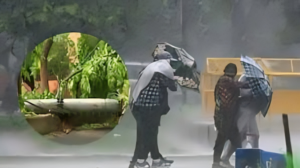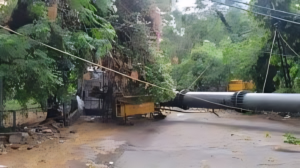When Delhi’s 100-Foot Mobile Tower Came Crashing Down: दिल्ली में 100 फुट मोबाइल टावर का अचानक ढहना
Introduction
Late one evening in East Delhi, residents were jolted awake by a thunderous roar as a 100‑foot mobile tower suddenly collapsed onto a busy street below. Within seconds, metal beams twisted like paper, vehicles screeched to a halt, and the calm of the neighbourhood turned into chaos. This unexpected disaster has raised urgent questions about infrastructure safety, maintenance protocols and community preparedness. In this article, we explore what happened, why it matters, and how we can prevent similar tragedies in the future.

The Incident Unfolded
On a warm summer night, the tower stood silently against the moonlit sky. Suddenly, with no warning, its base gave way:
- Time: Around 11:45 PM
- Location: Main road near Anand Vihar, East Delhi
- Immediate Impact: Fallen debris blocked two lanes; sparks from snapped cables caused minor fires; five vehicles were damaged
Local shopkeepers rushed out, calling emergency services, while neighbours pulled out their phones to livestream the unfolding scene. By the time fire and rescue teams arrived—within 15 minutes—the tower had already crushed a parked auto-rickshaw and bent streetlights like matchsticks.
Why Did It Collapse?
While a full investigation is underway, initial reports suggest multiple contributing factors:
- Aging Infrastructure:
- Installed nearly 15 years ago, the tower showed visible signs of rust and corrosion.
- Regular anti-corrosion paint coatings had lapsed.
- Monsoon Wear and Tear:
- Recent heavy rains likely weakened the soil around the foundation.
- Poor drainage aggravated waterlogging, reducing ground stability.
- Maintenance Lapses:
- The operating telecom company had belatedly scheduled structural audits.
- Local civic bodies report delays in issuing safety clearance certificates.
These technical shortcomings underscore a larger governance gap: when agencies and private operators fail to coordinate, public safety suffers.
Impact on the Community
Beyond metal and concrete, the collapse has left scars on local residents:
- Emotional Shock: Families living nearby report sleepless nights, fearing another collapse.
- Economic Disruption: Small businesses along the road faced closure for two days due to clean‑up operations.
- Traffic Chaos: Alternate routes became bottlenecks, adding an extra 30 minutes to daily commutes.
One auto‑driver, Ramesh Kumar, shared his ordeal: “I heard a loud crash and barely jumped out of my vehicle. If I’d been a few seconds later, I don’t want to imagine the consequences.” His story highlights how quickly everyday life can turn perilous.

Official Response and Safety Measures
Within hours, Delhi’s Disaster Management Authority (DDMA) convened an emergency meeting. Key actions announced:
- Immediate Inspections: All telecom towers over 50 feet to be audited within one week.
- Strict Enforcement: Fines up to ₹5 lakh for operators failing safety checks.
- Public Helpline: Dedicated hotline (1800‑TEL‑SAFE) for reporting structural concerns.
Meanwhile, the telecom provider pledged full cooperation:
“We regret the incident and are deploying rapid response teams for structural audits across all our towers in Delhi,” stated their spokesperson.
These steps aim to rebuild trust and ensure towers withstand both natural wear and extreme weather.
Lessons Learned & Moving Forward
To prevent future disasters, a multi‑pronged approach is essential:
- Proactive Maintenance:
- Scheduled anti‑corrosion treatments every two years.
- Geotechnical surveys before and after monsoon season.
- Community Engagement:
- Awareness drives teaching residents how to spot signs of structural fatigue.
- Mobile apps for easy risk reporting.
- Regulatory Overhaul:
- Clear timelines for audits and penalties for non‑compliance.
- Joint task forces combining civic engineers, telecom experts, and disaster officials.
By combining technology, governance and community vigilance, cities can fortify themselves against such infrastructural failures.
Conclusion
The collapse of Delhi’s 100‑foot mobile tower is a stark reminder that modern conveniences carry hidden risks. While towers deliver connectivity, they also demand rigorous upkeep and safety oversight. As Delhi moves to inspect and reinforce its skyline, residents can take heart in swift official action—but must remain vigilant. Ultimately, preventing the next collapse starts with timely maintenance, transparent governance and empowered communities working hand in hand.